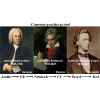In-depth analysis of music structure as a text network
引用次数: 0
Abstract
Music, enchanting and poetic, permeates every corner of human civilization. Although music is not unfamiliar to people, our understanding of its essence remains limited, and there is still no universally accepted scientific description. This is primarily due to music being regarded as a product of reason and emotion, making it difficult to define. This article treats musical texts as a complex system. This view echoes linguist John Rupert Firth's insight that understanding a word involves defining it through its surrounding relationships. To construct the network we first build a linear regression model with threshold values to assign conditions to the links among note, time, and volume. Then a clustering coefficient representing regional characteristics is utilized to define the word. Finally, the statistical distribution of the text is strictly required to adhere to the grammatical properties of statistical linguistics, such as Zipf's law, to adjust the weights of the linear regression model and achieve optimal results. These processes enable us to comprehend the structural differences in music across different periods with scientific rigor. Relying on the advantages of structuralism, we concentrate on the relationships and order between the physical elements of music, rather than getting entangled in the blurred boundaries of science and philosophy. Aside from serving as a bridge connecting music to natural language processing and knowledge graphs, the technical methods developed in this work offer a more intuitive approach to elucidate the relationships among elements of a complex network.

深入分析作为文本网络的音乐结构
音乐,充满魅力和诗意,渗透到人类文明的每一个角落。尽管人们对音乐并不陌生,但对其本质的理解却依然有限,至今仍没有一个公认的科学描述。这主要是由于音乐被认为是理性和情感的产物,因而难以定义。本文将音乐文本视为一个复杂的系统。这一观点与语言学家约翰-鲁珀特-费斯(John Rupert Firth)的见解不谋而合,即理解一个词需要通过其周围的关系对其进行定义。为了构建网络,我们首先建立了一个线性回归模型,用阈值为音符、时间和音量之间的联系分配条件。然后,利用代表区域特征的聚类系数来定义单词。最后,严格要求文本的统计分布符合统计语言学的语法特性,如齐普夫定律,以调整线性回归模型的权重,达到最佳效果。这些过程使我们能够以科学严谨的态度理解不同时期音乐的结构差异。依托结构主义的优势,我们专注于音乐物理元素之间的关系和秩序,而不是纠缠于科学和哲学的模糊界限。除了作为连接音乐与自然语言处理和知识图谱的桥梁外,这项工作中开发的技术方法还为阐明复杂网络元素之间的关系提供了一种更直观的方法。
本文章由计算机程序翻译,如有差异,请以英文原文为准。
求助全文
约1分钟内获得全文
求助全文

 求助内容:
求助内容: 应助结果提醒方式:
应助结果提醒方式:


